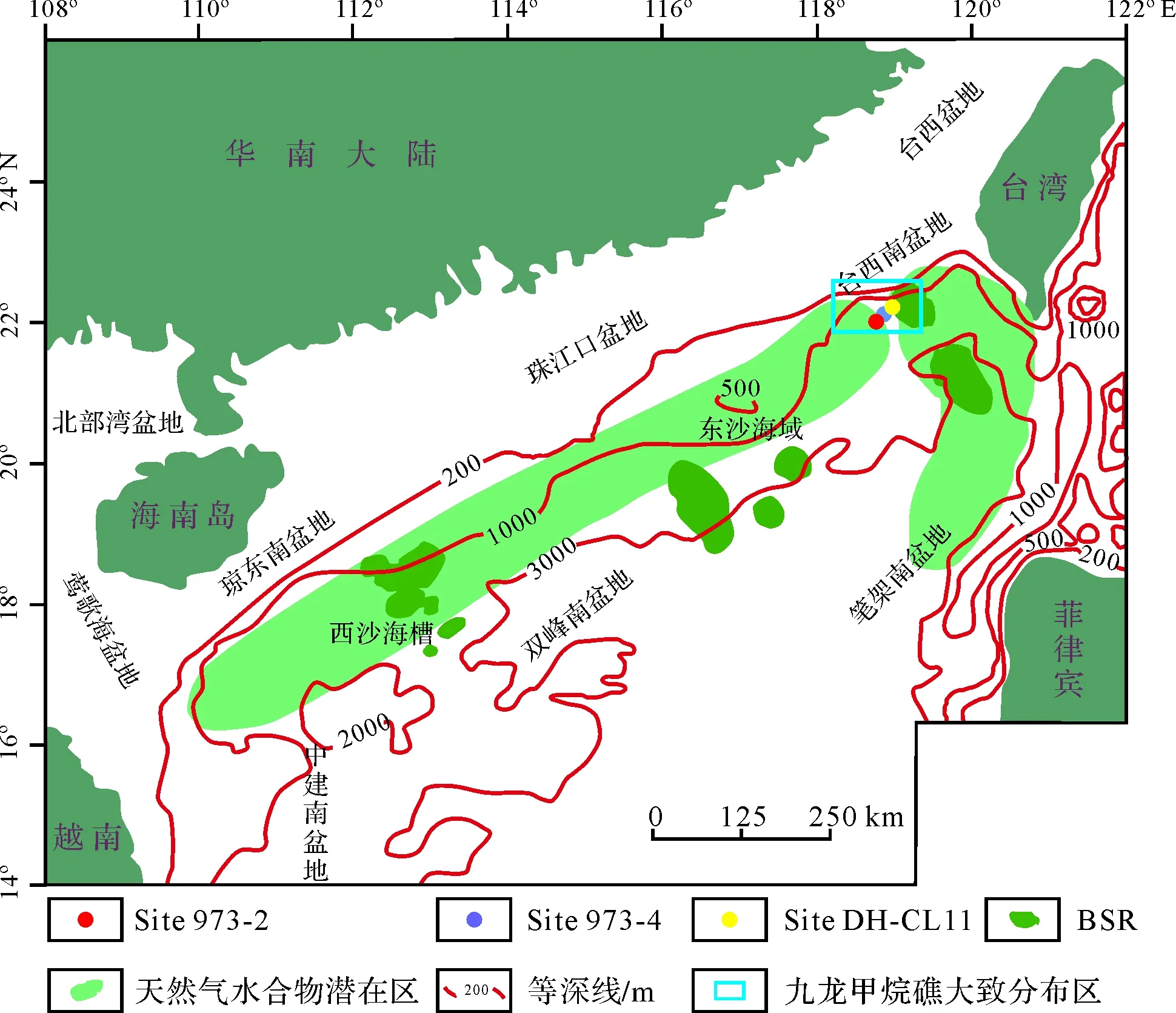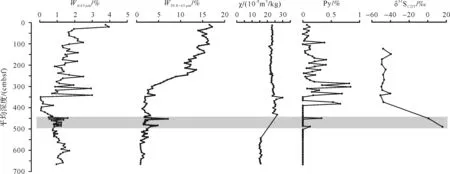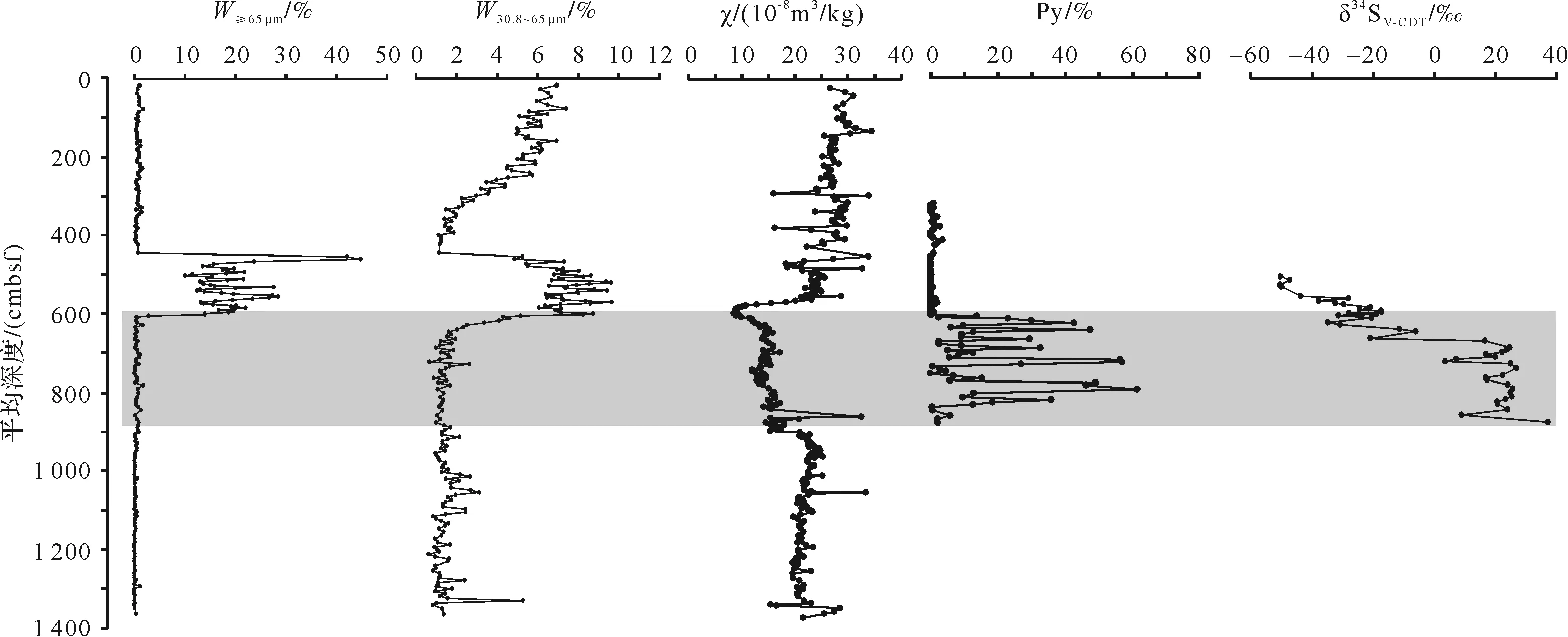南海东北部岩芯沉积物磁性特征及对甲烷事件的指示
林荣骁,王家生,苏丕波,林杞,孙飞,杨军霞
1. 生物地质与环境地质国家重点实验室,武汉 430074 2. 中国地质大学(武汉)地球科学学院,武汉 430074 3. 福州市海洋与渔业技术中心,福州 350026 4. 广州海洋地质调查局,广州 510075
南海东北部岩芯沉积物磁性特征及对甲烷事件的指示
林荣骁1,2,3,王家生1,2,苏丕波4,林杞2,孙飞2,杨军霞2
1. 生物地质与环境地质国家重点实验室,武汉 430074 2. 中国地质大学(武汉)地球科学学院,武汉 430074 3. 福州市海洋与渔业技术中心,福州 350026 4. 广州海洋地质调查局,广州 510075
在甲烷渗漏海域,沉积物磁化率通常表现出异常的低值特征,这与硫酸盐—甲烷转换带(SMTZ)内甲烷厌氧氧化反应(AOM)的发育而导致的自生矿物的形成作用有关。通过测定南海东北部Site DH-CL11、Site 973-2、Site 973-4三个站位400个岩芯沉积物样品的磁化率,并结合三个站位自生黄铁矿丰度和硫同位素等数据探讨了南海北部天然气水合物潜在区沉积物磁化率的变化特征及其对甲烷渗漏事件的指示意义。结果表明:在甲烷异常渗漏海域,上涌甲烷与下渗硫酸盐在SMTZ内发生AOM反应生成了大量的HS-,造成亚铁磁性矿物大量溶解,同时生成大量顺磁性自生黄铁矿,导致沉积物磁化率的异常降低;但是,在HS-不足时,铁硫化物黄铁矿化不充分,会优先生成胶黄铁矿,进而出现二次磁信号。在天然气水合物潜在海域,沉积物磁化率的异常特征可以反映下部甲烷通量的变化,从而指示下伏天然气水合物藏演化,因此能够成为探测天然气水合物藏的一种间接有效的手段,将有助于我国南海北部海域天然气水合物的勘探。
磁化率;自生黄铁矿;甲烷渗漏事件;南海东北部;沉积物
0 引言

1 区域地质概况
南海地处欧亚板块、澳大利亚板块以及太平洋板块交界处,北部陆缘属于华南地块,西部为印支地块,南接加里曼丹岛和苏门答腊岛,东邻台湾—菲律宾岛弧[8]。Site DH-CL11、Site 973-2和Site 973-4均位于南海北部被动大陆边缘和台湾西南部活动大陆边缘过渡带的九龙甲烷礁(Jiulong Methane Reef)海域分布区内(图1)。九龙甲烷礁总面积约430 km2,是目前世界上发现的面积最大的自生碳酸盐岩出露区[9]。ODP 184航次在九龙甲烷礁海域西南部的钻井资料显示,该海域沉积速率高达370~870 m/Ma[10]并且地震剖面上存在较强的似海底反射(BSR)[11],暗示下伏可能存在天然气水合物。

图1 研究站位分布图(修改自文献[12])Fig.1 Location of the study sites(modified from reference[12])
2 材料与方法
Site DH-CL11(21°57′ N,118°54′ E)岩芯沉积物样品来自2012年广州海洋地质调查局“海洋四号”利用大型重力活塞取样器采集的浅表层柱状样,站位水深约1 684 m,岩芯长7.67 m。Site 973-2(21°59′ N,118°46′ E)和Site 973-4(21°54′ N,118°49′ E)沉积物岩芯样品是2014年4月广州海洋地质调查局 “海洋六号”通过大型重力活塞取样器获取。其中,Site 973-2站位水深约1 120 m,岩芯长6.73 m;Site 973-4站位水深约1 666 m,岩芯长13.85 m。沉积物岩芯采集过程中,沉积物及其沉积组构未破坏。
沉积物样品采集于广州海洋地质调查局岩芯库,样品间距为2~5 cm,随后以锡箔纸包裹并转移到中国地质大学(武汉)生物地质与环境地质国家重点实验室(BGEG)内置于冰箱中冷冻保存,样品室内预处理工作在BGEG完成,部分样品测试在东华理工大学核资源与环境教育部重点实验室完成,过程如下:
(1) 采用取样器对岩芯柱沉积物样品进行定体积(约15 mL)取样并称量,随后置于阴凉处自然风干;
(2) 将风干后的样品进行称量,得到干样重(M干样),之后送至BGEG进行磁化率测试,首先称取约1~10 g样品,装入无磁性样品盒(2 cm×2 cm×2 cm),然后采用MFK1-FA多功能磁化率仪对研究区400个样品进行低场体积磁化率测量,并转换为质量磁化率χ。最后,使用MFK1-FA多功能磁化率仪完成Site 973-2样品κ/T曲线的测量;
(3) 将测试后样品用去离子水浸泡24 h,然后用直径分别为65 μm和30.8 μm的筛子对浸泡后的样品进行筛洗,筛洗过程中先在去离子水水流下用刷子轻刷,然后放入超声波清洗仪震荡5~10 s并倒回筛子中,再加入适量去离子水,重复以上步骤直至冲洗干净为止;
(4) 将冲洗干净的样品放入50°C恒温箱中烘干,待样品完全干燥后取出并分别称量粒径65 μm及以上的颗粒组分质量(M≥65μm)以及粒径在30.8~65 μm的颗粒组分质量(M30.8~65μm),分别计算出各组分质量百分比W≥65 μm,W30.8~65 μm(式1,2),然后转入容器中存放:
W≥65 μm(%)=100×M≥65 μm/M干样
(1)
W30.8~65 μm(%)=100×M30.8~65 μm/M干样
(2)
(5) 利用体视镜对粒径65 μm及以上的颗粒组分进行观察和自生矿物鉴定,随后挑选出自生黄铁矿集合体并进行称量,得到粒径65 μm及以上颗粒组分中自生黄铁矿的质量(MPy),并计算自生黄铁矿相对含量(式3):
Py(%)=100×MPy/M≥65μm
(3)
(6) 将挑选出的自生黄铁矿样品送到中国地质大学(武汉)地质过程与矿产资源国家重点实验室进行扫描电子显微镜(Scanning Electron Microscope,SEM)观察和能谱分析(Energy Dispersive Spectrum,EDS),仪器型号为FEI Quanta 450 FEG,再从能谱分析结果中得到各深度样品中自生黄铁矿Fe/S元素的原子比(Fe∶S);
(7) 对挑选出的自生黄铁矿样品进行硫同位素组成测试。其中Site 973-2黄铁矿硫同位素组成的测试工作在东华理工大学核资源与环境教育部重点实验室进行,测试仪器为FLASH EA和MAT 253,所有硫同位素数据均采用CDT(Canyon Diablo Troilite)标准,测试误差<0.2‰。Site 973-4和Site DH-CL11黄铁矿硫同位素组成的测试工作完成于BGEG,测试仪器为元素分析—同位素比值质谱仪(Delta V Plus)。数据经国际标准物质(IAEA-S1,IAEA-S2,IAEA-S3)校正VCDT(Viennadefined Canyon Diablo Troilite)标准,测试标准偏差<0.2‰。
3 结果
3.1 沉积物磁化率
磁化率是表征物质在外磁场中被磁化程度的物理量,磁化率的数值大小主要由沉积物中磁性矿物种类、含量和磁性颗粒的粒径组成等决定,它们在一定程度上能够反映物质来源、搬运过程、成岩作用等信息。在不同的沉积环境中,沉积物中磁性矿物的组合特征往往并不相同,主要受物质来源、沉积动力条件(如风化强度、搬运能量强弱等)以及沉积物在沉积后发生的物化反应这三个因素影响[13]。因此,不同沉积环境中磁性矿物组合特征的差异可以用于研究不同时空尺度下环境的变化过程及其机制。
Site DH-CL11站位的沉积物磁化率变化范围为12.78~46.27×10-8m3/kg,平均为27.90×10-8m3/kg(图2)。其中,在725.5~745.5 cmbsf(centimeters below sea floor,海底以下厘米)深度磁化率大幅降低,平均磁化率为13.24×10-8m3/kg;Site 973-2站位的沉积物磁化率变化范围为14.87~29.98×10-8m3/kg,平均为21.62×10-8m3/kg(图3)。其中,在547~667 cmbsf深度磁化率大幅降低,平均磁化率为15.48×10-8m3/kg;Site 973-4站位的沉积物磁化率变化范围为8.63~34.62×10-8m3/kg,平均为21.35×10-8m3/kg(图4)。其中,在570.5~896.5 cmbsf深度磁化率大幅降低,平均磁化率为14.43×10-8m3/kg。
3.2 自生黄铁矿的相对丰度及硫同位素
自生黄铁矿的相对含量及其硫同位素组成特征可以用于指示硫酸盐—甲烷转换带(SMTZ)的相对位置[14],在硫酸盐—甲烷转换带及其附近层位沉积物中,自生黄铁矿的相对含量增多并且硫同位素值往往有正偏趋势[14-17];从沉积物磁化率角度出发,黄铁矿属于顺磁性矿物,其正极磁化率近乎为零[13],若沉积物中出现大量黄铁矿,将对沉积物磁化率产生巨大影响。

图2 Site DH-CL11沉积物≥65 μm和30.8~65 μm粒度组分质量百分比、磁化率、自生黄铁矿丰度、硫同位素、Fe/S原子比随深度变化Fig.2 Mass percent of sediments with grain size ≥65 μm and 30.8~65 μm, magnetic susceptibility of sediments, authigenic pyrite abundance, sulfur isotope, Fe/S ratio variability with depths in Site DH-CL11

图3 Site 973-2沉积物≥65 μm和30.8~65 μm粒度组分质量百分比、磁化率、自生黄铁矿丰度、硫同位素随深度变化Fig.3 Mass percent of sediments with grain size ≥65 μm and 30.8~65 μm, magnetic susceptibility of sediments, authigenic pyrite abundance, sulfur isotope variability with depths in Site 973-2

图4 Site 973-4沉积物≥65 μm和30.8~65 μm粒度组分质量百分比、磁化率、黄铁矿丰度、硫同位素随深度变化Fig.4 Mass percent of sediments with grain size ≥65 μm and 30.8~65 μm, magnetic susceptibility of sediments, authigenic pyrite abundance, sulfur isotope variability with depths in Site 973-4
Site DH-CL11沉积物中自生黄铁矿丰度变化范围为0~15.506%,在745.5~765.5 cmbsf深度黄铁矿丰度显著增加;硫同位素变化范围为-50.246~-13.44‰V-CDT,在705.5~765.5 cmbsf深度存在明显正偏(图2)。Site 973-2沉积物中自生黄铁矿丰度整体较小,变化范围为0~0.917%;硫同位素变化范围为-50.48~+15.54‰CDT,在453~492.5 cmbsf深度存在明显正偏(图3)。Site 973-4沉积物中自生黄铁矿丰度变化范围为0~61.455%,在605.5~878 cmbsf深度黄铁矿丰度显著增加;硫同位素变化范围为-50.3~+37.2‰V-CDT,在584.5~878 cmbsf深度存在明显正偏(图4)。
4 讨论
4.1 甲烷渗漏背景下沉积物的磁化率变化机理

(4)
Fe2O3+ HS-+ 5H+→ 2Fe2++ S0+3H2O
(5)
Fe3O4+ HS-+ 7H+→ 3Fe2++ S0+ 4H2O
(6)

(7)
FeS + H2S → FeS2+ H2
(8)
3FeS + S0→ Fe3S4+ 2S0→ 3FeS2
(9)
3FeS + HS-→ Fe3S4+ 2HS-+ 2H+→ 3FeS2+ 4H+
(10)
在海洋环境中,HS-的生成速率和活性铁的含量共同控制着黄铁矿化过程[22]。在HS-过量且有足量活性铁的情况下黄铁矿化会充分进行,铁硫化物最终转化为稳定态的黄铁矿(FeS2)[28-29]。然而,HS-供应不足将导致部分黄铁矿化。因此,在低HS-浓度情况下,胶黄铁矿(Fe3S4)会先于黄铁矿沉淀(式9,10)并保存在海洋沉积物中。由于胶黄铁矿是亚铁磁性矿物,其磁化率值较大,这也导致沉积物磁化率在快速降低后的一定深度还会呈现第二次磁信号[7,30-31]。
4.2 沉积物磁化率特征对甲烷渗漏事件的指示
根据Linetal.[17]提出的识别paleo-SMTZ位置的经验模型,可以推断Site DH-CL11的paleo-SMTZ位于705.5~765.5 cmbsf深度;Site 973-2的paleo-SMTZ大概位于453~492.5 cmbsf深度;Site 973-4的paleo-SMTZ位于584.5~878 cmbsf深度。研究区三个站位的paleo-SMTZ位置均比神狐—东沙海域现今的SMI(Sulfate-Methane Interface)深度7.7~87.9 mbsf相对较浅[32]。由此可知,研究区深部上涌的含甲烷流体的通量曾经相当充足,硫酸盐—甲烷转换带位置的变迁以及甲烷厌氧氧化反应的速率主要受深部上涌的甲烷通量控制[33-34]。
从图2可以看出,Site DH-CL11在paleo-SMTZ内(705.5~765.5 cmbsf)沉积物磁化率先呈现出大幅度降低,而后呈现出异常增加,在765.5 cmbsf深度出现二次磁信号,自生黄铁矿丰度也出现异常高值,并且在705.5 cmbsf深度上下沉积物≥65 μm和30.8~65 μm粒度组分质量百分比并没有出现明显变化,表明该层位物源输入并未发生明显变化。此外在705.5 cmbsf以上层位自生黄铁矿Fe/S元素原子比(Fe∶S)接近1/2,但在Paleo-SMTZ内,Fe∶S均大于1/2,并且在745.5 cmbsf深度有样品Fe∶S接近3/4,表明paleo-SMTZ内很可能存在强磁性矿物胶黄铁矿。综上所述,推测Site DH-CL11沉积物磁化率变化原因可能与SMTZ位置变迁有关,即该站位在地史时期发生了持续时间较长的甲烷渗漏事件,长时间的AOM反应导致大量自生黄铁矿的生成,造成沉积物磁化率降低(705.5~745.5 cmbsf)。随着上涌甲烷通量减小,AOM反应强度减小,导致生成的HS-不足,后续铁硫化物的黄铁矿化停留在强磁性的胶黄铁矿阶段,导致沉积物磁化率在下降后出现二次磁信号。由于AOM反应强度减弱,硫酸盐还原速率降低,造成硫同位素的分馏增大[35-37],此时生成的自生黄铁矿以及胶黄铁矿的δ34S相对AOM反应强烈时期减小,745.5 cmbsf深度δ34SV-CDT的负偏趋势也证明这点。
由于缺乏440~540 cmbsf深度沉积物磁化率数据,无法确定Site 973-2在paleo-SMTZ内(453~492.5 cmbsf)沉积物磁化率具体变化,但根据整体磁化率变化趋势:在440 cmbsf以上层位沉积物磁化率呈现较高值,在540 cmbsf以下层位沉积物磁化率呈现低值,同时前人研究表明[31,38],在世界不同海洋环境中,沉积物对早期成岩作用的响应具有相似的磁性特征,在结构上普遍表现为上部高值带、中间下降带、底部最低带的三层结构。由此推测paleo-SMTZ内沉积物磁化率应呈降低趋势。从图3中可以看出453 cmbsf深度上下沉积物≥65 μm和30.8~65 μm粒度组分质量百分比并没有出现明显变化,表明该层位物源输入并未发生明显变化,物源输入对沉积物磁化率的影响较小,paleo-SMTZ内沉积物磁化率的降低可能与甲烷事件有关。此外,图5中在545~549、577~581和668~669 cmbsf深度,沉积物的κ-T升温曲线在240 ~360℃间形成平台形状的高值区,说明样品中存在胶黄铁矿[39-43]。280℃附近磁化率值的增高是胶黄铁矿的典型特征[39],样品在加热至240℃时磁化率值就出现小幅度的增大,可能是样品中含有其他居里温度较低的磁性矿物杂质所致,加热至360℃以后磁化率值的增大更为明显,表明样品中胶黄铁矿含量远小于黄铁矿含量[43],因此这三个深度中胶黄铁矿的出现并没有导致沉积物磁化率上升。
paleo-SMTZ之下的胶黄铁矿可能是通过以下两种机制形成:一是深部上涌甲烷通量不稳定导致短期内SMTZ频繁变迁,造成AOM反应生成的HS-无法储集下来,在HS-不足的情况下,铁硫化物的黄铁矿化停留在胶黄铁矿阶段,短期内SMTZ频繁变迁也造成该站位自生黄铁矿丰度整体较小;此外,也可能是paleo-SMTZ深度之下的自生黄铁矿厌氧氧化导致[44-46],具体反应如下:
(11)

从图4可以看出,Site 973-4在paleo-SMTZ内(584.5~878 cmbsf),沉积物磁化率的降低与自生黄铁矿丰度的增大耦合明显,但是在454.5~584.5 cmbsf深度,沉积物≥65 μm和30.8~65 μm粒度组分质量百分比均出现大幅增加,表明该层位物源输入可能发生了改变。前人研究表明[47],Site 973-4在该深度可能发生了重力流沉积,重力流沉积携带有大量陆源碎屑,本应导致沉积物磁化率上升,但该深度磁化率值却不断减小,说明Site 973-4岩芯虽然在584.5 cmbsf深度物源虽发生了改变,但并非是影响该处沉积物磁化率变化的主要原因。此外,王长昆[47]对该站位沉积物磁性特征的研究发现,在584.5~878 cmbsf深度,SIRM/χ异常增加,较大SIRM/χ是典型的胶黄铁矿特征[48],因此,推测该站位paleo-SMTZ深度内可能存在胶黄铁矿。但是,paleo-SMTZ内的强磁性胶黄铁矿并未导致沉积物磁化率上升,说明胶黄铁矿含量相对顺磁性的黄铁矿含量很小,并且是在黄铁矿沉淀之后生成。Site 973-4沉积物磁化率变化机理与Site DH-CL11相似:该站位曾在地史时期发生了持续时间较长的甲烷渗漏事件,长时间的AOM反应生成了大量自生黄铁矿,造成沉积物磁化率降低。之后,随着上涌甲烷通量减小,AOM反应强度减弱,生成的HS-不足,后续铁硫化物的黄铁矿化停留在胶黄铁矿阶段,但生成的胶黄铁矿含量相对黄铁矿含量很小,并未造成沉积物磁化率升高。

图5 Site 973-2沉积物κ-T曲线图其中a~f分别代表171~175 cmbsf、355~359 cmbsf、435~439 cmbsf、545~549 cmbsf、577~581 cmbsf、665~669 cmbsf深度沉积物к-T曲线Fig.5 κ-T curve of Site 973-2 sediments The alphabets a~f refer to sediments in 171~175 cmbsf,355~359 cmbsf,435~439 cmbsf,545~549 cmbsf,577~581 cmbsf,665~669 cmbsf water depth, respectively
4.3 沉积物的磁化率特征与水合物藏演化关系讨论
研究区三个站位在相对应的paleo-SMTZ深度内,沉积物磁化率均呈不同程度降低,二者间耦合性良好,这种突变式变化显然用物质来源、搬运过程和古气候变化无法解释。因此,我们认为在甲烷渗漏海域,深部上涌的甲烷与下渗的硫酸盐在SMTZ内发生AOM反应,生成大量的HS-,造成亚铁磁性矿物大量溶解同时大量顺磁性自生黄铁矿,导致沉积物磁化率的异常降低;但是,当HS-不足时,铁硫化物黄铁矿化不充分,优先生成强磁性的胶黄铁矿,出现二次磁信号。
在天然气水合物潜在区,上涌甲烷极有可能来自下伏天然气水合物藏失稳分解,因此,通过沉积物磁化率特征的变化能够反映下方甲烷通量的变化,指示下伏天然气水合物藏演化,进而为探测天然气水合物藏提供一种间接有效的手段。
5 结论
海洋环境中,沉积物磁化率特征的变化与甲烷渗漏事件关系密切,可以作为探测天然气水合物藏的间接手段。本文对南海东北部陆坡Site DH-CL11、Site 973-2、Site 973-4三个站位岩芯沉积物的磁化率特征进行测试和分析,表明Site DH-CL11在paleo-SMTZ深度内沉积物磁化率先大幅度降低而后异常增加,Site 973-2在paleo-SMTZ深度内沉积物磁化率呈现降低趋势,Site 973-4在paleo-SMTZ深度内沉积物磁化率大幅降低。
海底甲烷渗漏是研究区三个站位岩芯沉积物磁化率异常变化的主要原因。深部上涌甲烷与下渗硫酸盐在SMTZ内发生AOM反应,生成大量的HS-,造成亚铁磁性矿物大量溶解同时生成大量顺磁性黄铁矿,导致沉积物磁化率异常降低;当HS-不足时,铁硫化物的黄铁矿化不充分,优先生成强磁性胶黄铁矿,出现二次磁信号。
在天然气水合物潜在海域,上涌甲烷极有可能来自下伏天然气水合物藏失稳分解,通过测试沉积物磁化率特征可以快速指示下伏天然气水合物藏演化,有助于我国南海北部海域天然气水合物的勘探。
致谢 感谢中国地质大学(武汉)生物地质与环境地质国家重点实验室的朱宗敏老师和邓玉珍硕士在样品磁化率测试中的帮助。
References)
[1] Saunders D F, Burson K R, Thompson C K. Observed relation of soil magnetic susceptibility and soil gas hydrocarbon analyses to subsurface hydrocarbon accumulations[J]. AAPG Bulletin, 1991, 75(3): 389-408.
[2] Novosel I, Spence G D, Hyndman R D. Reduced magnetization produced by increased methane flux at a gas hydrate vent[J]. Marine Geology, 2005, 216(4): 265-274.
[3] 姚伯初,杨木壮,吴时国,等. 中国海域的天然气水合物资源[J]. 现代地质,2008,22(3):333-341. [Yao Bochu, Yang Muzhuang, Wu Shiguo, et al. The gas hydrate resources in the China seas[J]. Geoscience, 2008, 22(3): 333-341.]
[4] Ellwood B B, Balsam W L, Roberts H H. Gulf of Mexico sediment sources and sediment transport trends from magnetic susceptibility measurements of surface samples[J]. Marine Geology, 2006, 230(3/4): 237-248.
[5] Riedel M, Novosel I, Spence G D, et al. Geophysical and geochemical signatures associated with gas hydrate-related venting in the northern Cascadia margin[J]. Geological Society of America Bulletin, 2006, 118(1/2): 23-38.
[6] Usapkar A, Dewangan P, Kocherla M, et al. Enhanced methane flux event and sediment dispersal pattern in the Krishna-Godavari offshore basin: evidences from rock magnetic techniques[J]. Marine and Petroleum Geology, 2014, 58: 461-475.
[7] Dewangan P, Basavaiah N, Badesab F K, et al. Diagenesis of magnetic minerals in a gas hydrate/cold seep environment off the Krishna-Godavari basin, Bay of Bengal[J]. Marine Geology, 2013, 340: 57-70.
[8] 刘昭蜀,赵焕庭,范时清,等. 南海地质[M]. 北京:科学出版社,2002. [Liu Zhaoshu, Zhao Huanting, Fan Shiqing, et al. Geology of the South China Sea[M]. Beijing: Science Press, 2002.]
[9] Han Xiqiu, Suess E, Huang Yongyang, et al. Jiulong methane reef: microbial mediation of seep carbonates in the South China Sea[J]. Marine Geology, 2008, 249(3/4): 243-256.
[10] Shipboard Scientific Party. Leg 184 Summary: exploring the Asian monsoon through drilling in the South China sea[C]//Wang P, Prell W L, Blum P, et al. Proceedings of the Ocean Drilling Program, Initial Reports. College Station TX: Ocean Drilling Program, 2000, 184: 1-77.
[11] 宋海斌,耿建华,Wang H K,等. 南海北部东沙海域天然气水合物的初步研究[J]. 地球物理学报,2001,44(5):687-695. [Song Haibin, Geng Jianhua, Wang H K, et al. A preliminary study of gas hydrates in Dongsha region north of South China Sea[J]. Chinese Journal of Geophysics, 2001, 44(5): 687-695.]
[12] 张劼,雷怀彦,欧文佳,等. 南海北部陆坡973-4柱沉积物中硫酸盐——甲烷转换带(SMTZ)研究及其对水合物的指示意义[J]. 天然气地球科学,2014,25(11):1811-1820. [Zhang Jie, Lei Huaiyan, Ou Wenjia, et al. Research of the sulfate-methane transition zone (SMTZ) in sediments of 973-4 column in continental slope of northern South China Sea[J]. Natural Gas Geoscience, 2014, 25(11): 1811-1820.]
[13] Thompson R, Oldfield F. Environmental Magnetism[M]. London: Allen & Unwin, 1986.
[14] Borowski W S, Rodriguez N M, Paull C K, et al. Are34S-enriched authigenic sulfide minerals a proxy for elevated methane flux and gas hydrates in the geologic record?[J]. Marine and Petroleum Geology, 2013, 43: 381-395.
[15] PeketiA, Mazumdar A, Joshi R K, et al. Tracing the Paleo sulfate-methane transition zones and H2S seepage events in marine sediments: an application of C-S-Mo systematics[J]. Geochemistry, Geophysics, Geosystems, 2012, 13(10): Q10007.
[16] Jørgensen B B, Böttcher M E, Lüschen H, et al. Anaerobic methane oxidation and a deep H2S sink generate isotopically heavy sulfides in Black Sea sediments[J]. Geochimica et Cosmochimica Acta, 2004, 68(9): 2095-2118.
[17] Lin Qi, Wang Jiasheng, Taladay K, et al. Coupled pyrite concentration and sulfur isotopic insight into the paleo sulfate-methane transition zone (SMTZ) in the northern South China Sea[J]. Journal of Asian Earth Sciences, 2016, 115: 547-556.
[18] Jørgensen B B, Kasten S. Sulfur cycling and methane oxidation[M]//Schulz H D, Zabel M. Marine Geochemistry. 2nd ed. Berlin: Springer, 2006.
[20] Berner R A. Sedimentary pyrite formation[J]. American Journal of Science, 1970, 268(1): 1-23.
[21] Sweeney R E, Kaplan I R. Pyrite framboid formation: laboratory synthesis and marine sediments[J]. Economic Geology, 1973, 68(5): 618-634.
[22] Berner R A. Sedimentary pyrite formation: an update[J]. Geochimica et Cosmochimica Acta, 1984, 48(4): 605-615.
[23] Wilkin R T, Barnes H L. Formation processes of framboidal pyrite[J]. Geochimica et Cosmochimica Acta, 1997, 61(2): 323-339.
[24] Hurtgen M T, Lyons T W, Ingall E D, et al. Anomalous enrichments of iron monosulfide in euxinic marine sediments and the role of H2S in iron sulfide transformations: examples from Effingham Inlet, Orca Basin, and the Black Sea[J]. American Journal of Science, 1999, 299(7/8/9): 556-588.
[25] Poulton S W, Krom M D, Raiswell R. A revised scheme for the reactivity of iron (oxyhydr) oxide minerals towards dissolved sulfide[J]. Geochimica et Cosmochimica Acta, 2004, 68(18): 3703-3715.
[26] Shen Yanan, Buick R. The antiquity of microbial sulfate reduction[J]. Earth-Science Reviews, 2004, 64(3/4): 243-272.
[27] Hunger S, Benning L G. Greigite: a true intermediate on the polysulfide pathway to pyrite[J]. Geochemical Transactions, 2007, 8: 1.
[28] Berner R A. Thermodynamic stability of sedimentary iron sulfides[J]. American Journal of Science, 1967, 265(9): 773-785.
[29] Mazumdar A, Peketi A, Joao H, et al. Sulfidization in a shallow coastal depositional setting: diagenetic and palaeoclimatic implications[J]. Chemical Geology, 2012, 322-323: 68-78.
[30] Rowan C J, Roberts A P. Magnetite dissolution, diachronous greigite formation, and secondary magnetizations from pyrite oxidation: unravelling complex magnetizations in Neogene marine sediments from New Zealand[J]. Earth and Planetary Science Letters, 2006, 241(1/2): 119-137.
[31] Rowan C J, Roberts A P, Broadbent T. Reductive diagenesis, magnetite dissolution, greigite growth and paleomagnetic smoothing in marine sediments: a new view[J]. Earth and Planetary Science Letters, 2009, 277(1/2): 223-235.
[32] 吴庐山,杨胜雄,梁金强,等. 南海北部神狐海域沉积物中孔隙水硫酸盐梯度变化特征及其对天然气水合物的指示意义[J]. 中国科学(D辑):地球科学,2013,43(3):339-350. [Wu Lushan, Yang Shengxiong, Liang Jinqiang, et al. Variations of pore water sulfate gradients in sediments as indicator for underlying gas hydrate in Shenhu Area, the South China Sea[J]. Science China(Seri.D): Earth Sciences, 2013, 43(3): 339-350.]
[33] Borowski W S, Paull C K, Ussler III W. Marine pore-water sulfate profiles indicate in situ methane flux from underlying gas hydrate[J]. Geology, 1996, 24(7): 655-658.
[34] Borowski W S, Paull C K, Ussler III W. Global and local variations of interstitial sulfate gradients in deep-water, continental margin sediments: sensitivity to underlying methane and gas hydrates[J]. Marine Geology, 1999, 159(1/2/3/4): 131-154.
[35] Habicht K S, Canfield D E. Sulfur isotope fractionation during bacterial sulfate reduction in organic-rich sediments[J]. Geochimica et Cosmochimica Acta, 1997, 61(24): 5351-5361.
[36] Habicht K S, Canfield D E. Isotope fractionation by sulfate-reducing natural populations and the isotopic composition of sulfide in marine sediments[J]. Geology, 2001, 29(6): 555-558.
[37] Canfield D E. Isotope fractionation by natural populations of sulfate-reducing bacteria[J]. Geochimica et Cosmochimica Acta, 2001, 65(7): 1117-1124.
[38] Mohamed K J, Rey D, Rubio B, et al. Onshore-offshore gradient in reductive early diagenesis in coastal marine sediments of the Ria de Vigo, Northwest Iberian Peninsula[J]. Continental Shelf Research, 2011, 31(5): 433-447.
[39] Roberts A P. Magnetic properties of sedimentary greigite (Fe3S4)[J]. Earth and Planetary Science Letters, 1995, 134(3/4): 227-236.
[40] Skinner B J, Erd R C, Grimaldi F S. Greigite, the thio-spinel of iron: a new mineral[J]. American Mineralogist, 1964, 49: 543-555.
[41] Dekkers M J. Magnetic properties of natural pyrrhotite. II. High-and low-temperature behaviour of Jrsand TRM as function of grain size[J]. Physics of the Earth and Planetary Interiors, 1989, 57(3/4): 266-283.
[42] Torii M, Fukuma K, Horng C S, et al. Magnetic discrimination of pyrrhotite-and greigite-bearing sediment samples[J]. Geophysical Research Letters, 1996, 23(14): 1813-1816.
[43] 汪卫国,戴霜,陈莉莉,等. 白令海和西北冰洋表层沉积物磁化率特征初步研究[J]. 海洋学报,2014,36(9):121-131. [Wang Weiguo, Dai Shuang, Chen Lili, et al. Magnetic susceptibility characteristics of surface sediments in Bering Sea and western Arctic Ocean: preliminary results[J]. Acta Oceanologica Sinica, 2014, 36(9): 121-131.]
[44] Bottrell S H, Parkes R J, Cragg B A, et al. Isotopic evidence for anoxic pyrite oxidation and stimulation of bacterial sulphate reduction in marine sediments[J]. Journal of the Geological Society, 2000, 157(4): 711-714.
[45] Jiang W T, Horng C S, Roberts A P, et al. Contradictory magnetic polarities in sediments and variable timing of neoformation of authigenic greigite[J]. Earth and Planetary Science Letters, 2001, 193(1/2): 1-12.
[47] 王长昆. 南海东沙晚更新世深水沉积物的磁性特征及其环境意义[D]. 北京:中国地质大学(北京),2013. [Wang Changkun. The magnetic parameters and its environmental implications in sediments since Late Pleistocene from Dongsha area, South China Sea[D]. Beijing: China University of Geosciences (Beijing), 2013.]
[48] Roberts A P, Reynolds R L, Verosub K L, et al. Environmental magnetic implications of greigite (Fe3S4) formation in a 3 m.y. lake sediment record from Butte Valley, northern California[J]. Geophysical Research Letters, 1996, 23(20): 2859-2862.
Characteristics of Magnetic Susceptibility of Cored Sediments and Their Implications for the Potential Methane Events in Northern South China Sea
LIN RongXiao1,2,3,WANG JiaSheng1,2,SU PiBo4,LIN Qi2,SUN Fei2,YANGJunXia2
1. State Key Laboratory of Biogeology and Environmental Geology, China University of Geosciences, Wuhan 430074, China 2. Faculty of Earth Science, China University of Geosciences, Wuhan 430074, China 3. Fuzhou Ocean and Fisheries Technology Center, Fuzhou 350026, China 4. Guangzhou Marine Geological Survey, Guangzhou 510075, China
In marine methane seepage areas, sedimentary magnetic susceptibility was characterized by abnormally low values, which was related to the formation of authigenic minerals resulted from the anaerobic methane oxidation (AOM) within the sulfate-methane transition zone (SMTZ). In this study, 400 sedimentary core samples from Site DH-CL11, Site973-2 and Site973-4 drilled in the northern South China Sea were measured. In connection with the relative content and the sulfur isotopic values of the authigenic pyrites handpicked from the aforementioned 3 sites, the variation characteristics of sedimentary magnetic susceptibility and its indication for methane seep events at the potential gas hydrate areas in the northern South China Sea were discussed. At Site DH-CL11, sedimentary magnetic susceptibility first significantly decreased and then abnormally increased within the paleo-SMTZ (705.5~765.5 cmbsf), which is probably related to the depth change of the SMTZ. At Site 973-2, sedimentary magnetic susceptibility showed a decreasing trend within the paleo-SMTZ (453~492.5 cmbsf). Greigites were discovered under the SMTZ, which may be related to frequent changes of the SMTZ or the anaerobic oxidation of authigenic pyrites. At Site 973-4, sedimentary magnetic susceptibility significantly decreased within the paleo-SMTZ (584.5~878 cmbsf), which was considered to be resulted from methane seep events. In general, these results show that under the methane seepage environments, HS-produced by AOM reacts with magnetic minerals in sediments, resulting in the dissolution of magnetic minerals coupled with precipitation of paramagnetic pyrite, both of which will make an anomalously low MS value in the SMTZ; However, with low HS-concentration, insufficient supply of HS-will lead to partial pyritization, which will result in the preferential formation of greigites followed by secondary magnetic susceptibility signals. Therefore, in gas hydrate prospecting areas, abnormal characteristics of the sedimentary magnetic susceptibility are feasible to indicate deep methane flux variation, thus to show a further indication for the evolution of the underlying gas hydrate occurrence. The abnormal characteristic of sedimentary magnetic susceptibility becomes an indirect but available method to explore gas hydrate occurrence, which is helpful for gas hydrate exploration in the northern South China Sea.
magnetic susceptibility; authigenic pyrites; methane events; northeastern SCS; sediments
1000-0550(2017)02-0290-09
10.14027/j.cnki.cjxb.2017.02.008
2016-04-19; 收修改稿日期: 2016-05-19
国家自然科学基金(41472085);南海天然气水合物成矿理论及分布预测研究专题(GZH20110030-50603)[Foundation:National Natural Science Foundation of China, No. 41472085; National Project of Exploration and Test Production for Gas Hydrate, No. GZH20110030-50603]
林荣骁,男,1991年出生,硕士研究生,海洋天然气水合物沉积学和矿物学,E-mail: 296992305@qq.com
王家生,男,教授,E-mail: js-wang@cug.edu.cn
P736.21+1
A

